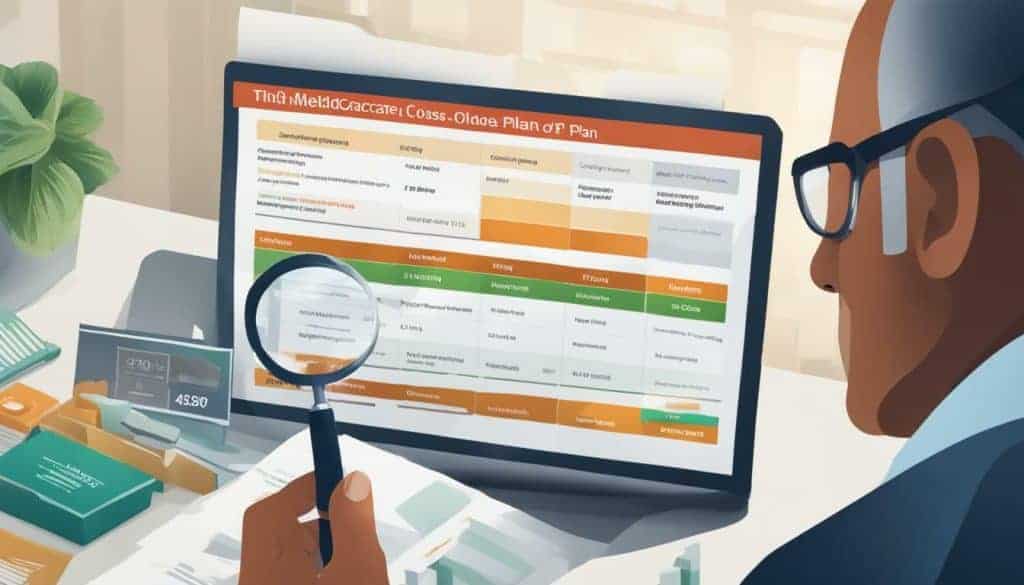Medicare Supplement Plan N provides important healthcare coverage for Medicare beneficiaries, but it’s important to understand if excess charges by providers are common. Excess charges occur when a healthcare provider charges more than the approved Medicare amount for services covered under Medicare Part B. In this article, we will explore the prevalence of excess charges for Medicare Supplement Plan N and provide an overview of the coverage and costs associated with this plan.
- Medicare Supplement Plan N does not cover excess charges for Medicare Part B.
- Excess charges can result in higher out-of-pocket costs for Medicare beneficiaries.
- Plan N has lower premiums compared to Plan G, but it also has more out-of-pocket costs, such as copayments for doctor visits and emergency room visits.
- Plan F, the most popular Medigap plan, is no longer available to new Medicare beneficiaries, but those eligible before January 1, 2020, can still enroll in Plan F.
- Plan G and Plan N are considered good alternatives to Plan F.
Understanding Medicare Supplement Plan N Coverage
Medicare Supplement Plan N offers comprehensive coverage for Medicare beneficiaries, but it’s crucial to understand its limitations, especially when it comes to excess charges by providers. Plan N, like other Medigap plans, is designed to fill in the gaps left by Original Medicare. It helps cover out-of-pocket costs such as deductibles, copayments, and coinsurance. However, it’s important to note that Plan N does not cover excess charges for Medicare Part B.
Excess charges occur when a healthcare provider charges more than the approved Medicare amount. Medicare has set a limit on what healthcare providers can charge for services covered by Medicare. However, some providers choose to charge more than this approved amount, resulting in excess charges. If you have Plan N, you may be responsible for paying these excess charges out of pocket, which could potentially increase your healthcare costs.
To put it simply, while Medicare Supplement Plan N provides comprehensive coverage for many healthcare services, it does not protect you from excess charges. It’s essential to be aware of this potential cost when considering Plan N as your Medigap plan of choice. However, it’s worth noting that not all healthcare providers charge excess fees, so it’s important to research and choose providers who accept Medicare assignment, which means they accept the approved Medicare amount as full payment for covered services.
What Plan N Covers
Medicare Supplement Plan N covers a wide range of services, including hospitalization, skilled nursing facility care, and Part A deductible. It also covers 100% of the Part B coinsurance, except for a copayment of up to $20 for a doctor’s office visit and up to $50 for a visit to the emergency room. Additionally, it offers coverage for foreign travel emergencies and preventive services.
Plan N can be a good option for those who are willing to pay a small copayment for certain services in exchange for lower monthly premiums. It’s important to compare the costs and coverage of Plan N with other Medigap plans, such as Plan G, to determine which plan best meets your needs and budget.
| Plan N Coverage | Plan N Costs |
|---|---|
| Medicare Part A coinsurance and hospital costs | Premiums |
| Medicare Part B coinsurance or copayment | Doctor’s office visit copayment: Up to $20 |
| First 3 pints of blood | Emergency room visit copayment: Up to $50 |
| Part A hospice care coinsurance or copayment | |
| Skilled nursing facility care coinsurance | |
| Part A deductible | |
| Foreign travel emergency coverage | |
| Preventive services |

Excess charges can become a concern for Medicare beneficiaries with Medicare Supplement Plan N, especially when it comes to Medicare Part B services. Medicare Part B covers outpatient care, including doctor visits, medical supplies, and preventive services. While Medicare Part B does provide coverage for these services, the amount that Medicare pays may not always match the amount charged by healthcare providers.
Medicare sets an approved amount for each service covered under Part B. This approved amount is based on the Medicare fee schedule, which is a list of maximum allowable charges set by the government. However, some healthcare providers may choose to charge more than the approved amount. These additional charges are known as excess charges.
It’s important to note that Medicare Supplement Plan N does not cover excess charges for Medicare Part B. This means that if your healthcare provider charges more than the approved Medicare amount, you will be responsible for paying the difference out of pocket. This can result in higher out-of-pocket costs, especially if you require frequent or specialized medical services.

To avoid excessive costs, it’s important to carefully consider your healthcare needs and budget when choosing a Medicare Supplement plan. While Plan N may have lower premiums compared to other plans, it’s essential to factor in the potential for higher out-of-pocket costs, including excess charges. Plan G and Plan F, although no longer available to new beneficiaries, may be good alternatives for those who are concerned about excess charges and want more comprehensive coverage. It’s always advisable to review all available options and consult with a licensed insurance agent or Medicare specialist to determine the best plan for your specific needs.
Comparing Plan N to Other Medigap Plans
To make an informed decision about Medicare Supplement Plan N, it’s important to compare it to other Medigap plans available and consider any potential excess charges. While Plan N offers comprehensive coverage, it’s essential to understand how it differs from other plans such as Plan G and the now-unavailable Plan F.
Plan N provides coverage for most of the essential benefits offered by Medigap plans, including coverage for Medicare Part A coinsurance and hospital costs, as well as coverage for Part B coinsurance or copayments.
One key difference between Plan N and other plans is the cost-sharing associated with certain medical services. With Plan N, you are responsible for a $20 copayment for doctor visits and a $50 copayment for emergency room visits. Additionally, Plan N does not cover excess charges for Medicare Part B, which can be a consideration if your healthcare provider charges more than the approved Medicare amount.
It’s important to note that Plan F, which is the most popular Medigap plan, is no longer available to new Medicare beneficiaries, but those who were eligible for Medicare before January 1, 2020, can still enroll in Plan F. Plan G and Plan N are considered to be good alternatives to Plan F.
Comparison Table: Plan N vs. Plan G vs. Plan F
| Plan Features | Plan N | Plan G | Plan F |
|---|---|---|---|
| Coverage for Part A coinsurance and hospital costs | ✓ | ✓ | ✓ |
| Coverage for Part B coinsurance or copayments | ✓ | ✓ | ✓ |
| Coverage for Part A deductible | ✗ | ✓ | ✓ |
| Coverage for Part B excess charges | ✗ | ✓ | ✓ |
| Coverage for skilled nursing facility coinsurance | ✓ | ✓ | ✓ |
| Coverage for foreign travel emergencies | ✓ | ✓ | ✓ |
| Cost-sharing for doctor visits | $20 copay | ✗ | ✗ |
| Cost-sharing for emergency room visits | $50 copay | ✗ | ✗ |
When comparing Plan N to other Medigap plans, it’s essential to consider your individual healthcare needs and budget. While Plan N may have lower premiums compared to Plan G, the cost-sharing for certain services, and the lack of coverage for Part B excess charges, may result in higher out-of-pocket costs in the long run.
Ultimately, the right Medigap plan for you will depend on your specific circumstances and preferences. It’s advisable to consult with a licensed insurance agent or Medicare specialist who can provide personalized guidance and help you choose the plan that best suits your needs.

When considering Medicare Supplement Plan N, it’s essential to evaluate both the cost of the plan itself and the potential for excess charges by healthcare providers. While Plan N offers lower premiums compared to Plan G, it’s important to understand that there are additional out-of-pocket costs that may arise.
Under Plan N, you’ll have a $20 copay for each doctor visit and a $50 copay for each visit to the emergency room. These copayments can add up, especially if you require frequent medical care. It’s crucial to factor in these costs when deciding whether Plan N is the right choice for you.
One advantage of Medicare Supplement Plan N is that it does not cover excess charges for Medicare Part B. Excess charges occur when a healthcare provider charges more than the approved Medicare amount. This means that if you choose Plan N, you’ll be responsible for any excess charges that your healthcare provider may impose.
It’s important to note that Plan F, which was the most popular Medigap plan, is no longer available to new Medicare beneficiaries. However, if you were eligible for Medicare before January 1, 2020, you can still enroll in Plan F. Plan G and Plan N are considered to be good alternatives to Plan F, offering comprehensive coverage at more affordable prices.
| Plan Name | Coverage | Premiums | Out-of-Pocket Costs | Excess Charges |
|---|---|---|---|---|
| Plan N | Comprehensive | Lower than Plan G | $20 copay for doctor visits; $50 copay for emergency room visits | Not covered |
| Plan G | Comprehensive | Higher than Plan N | $0 copay for doctor visits; $50 copay for emergency room visits | Not covered |
| Plan F | Most comprehensive | Highest | $0 copay for doctor visits; $0 copay for emergency room visits | Not covered |
In summary, Medicare Supplement Plan N offers a balance between coverage and cost. It has lower premiums compared to Plan G but comes with copayments for doctor and emergency room visits. Excess charges for Medicare Part B are not covered under Plan N. When making your decision, consider your healthcare needs, budget, and the potential for extra out-of-pocket costs.

In conclusion, understanding the prevalence of Medicare Supplement Plan N excess charges by providers is crucial for Medicare beneficiaries considering this coverage option. While Plan N offers comprehensive coverage for Medicare Part A, it does not cover excess charges for Medicare Part B. Excess charges can occur when healthcare providers charge more than the approved Medicare amount, resulting in higher out-of-pocket costs for beneficiaries.
Although Plan N provides lower premiums compared to Plan G, it comes with more cost-sharing in the form of copayments for certain services. For instance, a doctor visit may require a $20 copay, while an emergency room visit may have a $50 copay. These out-of-pocket expenses should be carefully considered when evaluating the overall cost of Plan N.
It’s worth noting that Medicare Supplement Plan F, which was one of the most popular Medigap plans, is no longer available to new Medicare beneficiaries. However, those who were eligible for Medicare before January 1, 2020, can still enroll in Plan F. Plan G and Plan N are considered to be good alternatives to Plan F, providing comprehensive coverage and potential cost savings.
Before making a decision, Medicare beneficiaries should carefully compare the coverage, costs, and potential excess charges associated with different Medicare Supplement plans. By understanding these factors, individuals can make an informed choice that best meets their healthcare needs and financial situation.
FAQ
Q: Are Medicare Supplement Plan N excess charges common?
A: Medicare Supplement Plan N does not cover excess charges for Medicare Part B. Excess charges occur when a healthcare provider charges more than the approved Medicare amount.
Q: What does Medicare Supplement Plan N cover?
A: Medicare Supplement Plan N provides coverage for a range of healthcare services, including hospital stays, skilled nursing care, and blood transfusions. However, it does not cover excess charges for Medicare Part B.
Q: How does Medicare Supplement Plan N compare to Plan G?
A: Medicare Supplement Plan N has lower premiums compared to Plan G. However, Plan N also has more out-of-pocket costs, such as a $20 copay for a doctor visit and a $50 copay for an emergency room visit.
Q: Is Plan F still available to new Medicare beneficiaries?
A: No, Plan F is no longer available to new Medicare beneficiaries. However, those who were eligible for Medicare before January 1, 2020, can still enroll in Plan F.
Q: Which Medigap plans are considered good alternatives to Plan F?
A: Plan G and Plan N are considered to be good alternatives to Plan F. They provide similar coverage options with varying levels of out-of-pocket costs.










